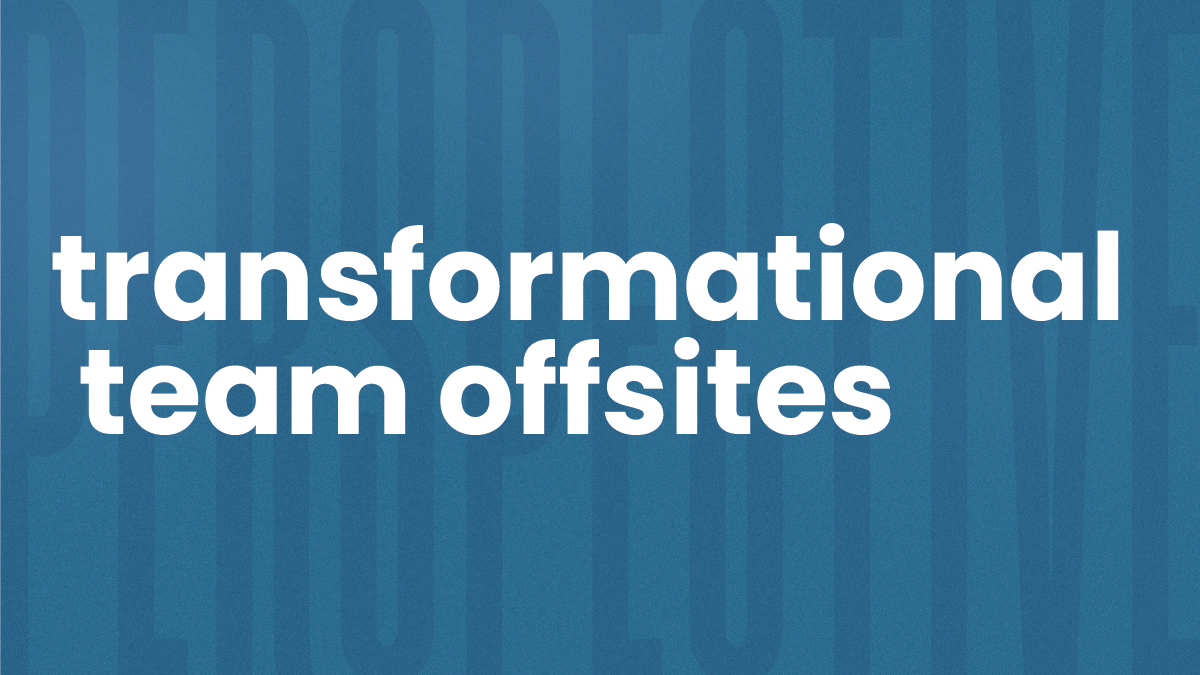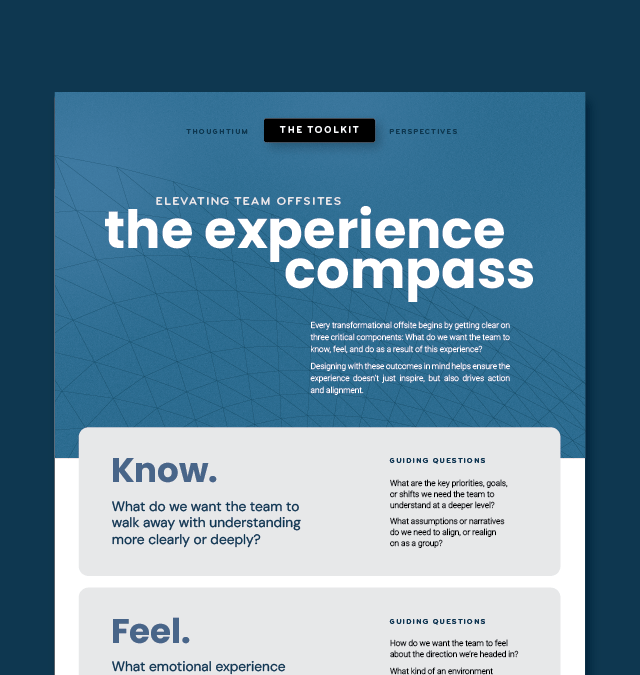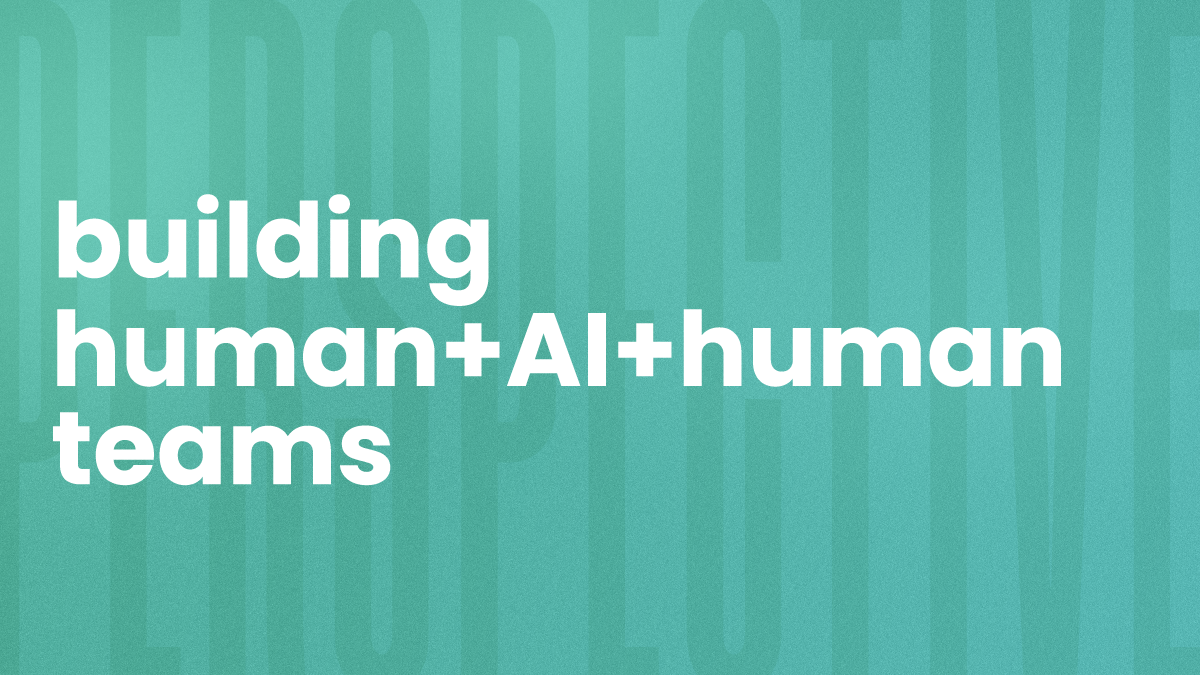Read: What Makes an Offsite Truly Transformational?

It starts with the leader.
Not a playbook. Not a multi-day agenda.
A transformational offsite starts with the leader seeing major opportunity on the horizon: a merger, a shift in strategic direction, a culture in need of repair. And it’s the leader who takes action, instinctively knowing: this can’t be another meeting.
Offsites are often undervalued or misused, seen as “time away” rather than time to reset and refocus. But research proves otherwise: 65% of organizations with strong project-strategy alignment report above-average performance, compared to only 35% for those without it (Project Management Institute, The High Cost of Low Performance, 2014). Strategic offsites create the space where that alignment, and the elevation of both people and priorities, actually happens.
The Power of the Pause
Offsites are a powerful invitation to pause. Not just to stop the work, but to elevate, zoom out and work on the business instead of in it. When designed well, they interrupt the noise of day-to-day execution and make space for something far more valuable: perspective.
Thoughtium’s research and experience shows that teams are often simply performing to meet immediate needs of the business. Leaders are often stuck solving big problems in small meeting windows. A transformational offsite is a deliberate reset-a moment to reflect, reconnect, and reimagine. It’s an opportunity to solve big business challenges by tapping into the collective genius of the team.
At Thoughtium, we help leaders design human-centered experiences that inspire growth. And the team offsite? That’s one of the most transformative experiences a team can undergo, when it’s done right.

Core Functions of a Great Offsite
A great strategic offsite balances two core functions:
- Relational Work: Cultivating connection, psychological safety, and team identity.
- Strategic Work: Creating direction, clarity, and energy around what matters most in the business.
The order matters. The time you invest in each matters. And most importantly, how you design for both matters.

Here’s what research, experience, and transformation in the field have taught us:
Pause and Connect as Individuals
Before you work on the business, you need to work with your people. Personal connection creates trust; and trust transforms how teams show up for each other and for the business.
Team offsites need to create the conditions where everyone feels safe, heard, and valued. That starts with intentionally slowing down and connecting as humans first.
What this looks like in practice:
- Grounding Practices: Inviting simple somatic practices can help the team arrive more fully present, regulated, and ready to engage. Consider diaphragmatic breathwork, mindful movement, or even nature immersion.
- Create the Space Questions: Use thoughtful check-in questions to invite each person to land in the space, not just physically but relationally. Consider asking, “What’s something that’s brought you joy recently?” or “What’s one word to describe how you’re arriving today?”
- Inclusive Design: Honor the full spectrum of how people think, feel, and process- considering introverts and extroverts, neurodivergent and neurotypical. This might mean building in quiet reflection time or creating opt-in activities. When everyone’s needs are considered, belonging deepens and contribution follows.
When team connection is prioritized, our strategy sharpens, our execution improves, and our creativity expands.
Watch the Perspectives Episode for Real Talk from Industry Leaders
Create the Space for Collective Thinking
Once we’ve created the space for connection and the individual, we can move to the collective. This is the core differentiator between a meeting and an offsite: the space for collective thinking.
Team offsites need moments for co-creation and ideation, not just business content consumption. It’s a valuable opportunity for teams to co-create, and instead of bypassing tension, to move through misalignment.
What this looks like in practice:
- Build Perspective: One of our core Thoughtium Experiences, This is Our Moment, creates the space for teams to reflect on the behaviors and practices that are serving them, and those that aren’t. This co-creates a shared commitment to the path forward and captures the mindset shift they’re stepping into. Interested in learning more? Schedule a free demo to experience this solution.
- “From/To” Mapping: Teams articulate where they are now and where they want to be in the next 2 years-an exercise in future mapping and intentional shifts.
- What Could Get in Our Way?: A facilitated dialogue where the team looks around future corners and anticipates what might get in the way of their success. By naming potential tensions, unspoken dynamics, or past patterns that could resurface, the group builds trust and clears the path for forward momentum.
These tools open up space for clarity and courage; two things teams desperately need, but rarely get in their day-to-day sprint.
Tackle the Big Business Challenge
Now, you are ready to work on the business.
This is an opportunity to step up and out of your day-to-day to name and navigate the business's most pressing challenges. A 10,000-foot view allows you to reimagine, not just reorganize.
This isn't a firehouse of updates, but a moment to step into thought leadership, as a team and tackle key strategic challenges, together. Stepping outside of our day-to-day creates the space to ask the real questions: How are we evolving? What's coming next? What bold moves are we ready for?
What this can look like:
- Big Rocks Exercise: Identify and align on the 2–3 most critical strategic priorities, the “big rocks”, for the next quarter or year. This helps the team filter noise, focus energy, and commit to meaningful progress. Curious how to apply this? Schedule a demo to explore what this might look like for your team!
- Strategic Scenario Mapping: Teams explore multiple versions of the future by asking: What might change in our landscape? What are the bold plays we haven’t considered? Map these scenarios visually to help teams expand their thinking, evaluate risk, and build agility into the strategy.
- Assumption Busting: Uncover outdated beliefs, blind spots, and invisible constraints- opening the door for innovation and renewed clarity. Use prompts like “What do we believe to be true about our customer / product / market that might no longer serve us?” to challenge legacy thinking.
An offsite is not about stepping away from work. It’s not a forum for business updates. It’s about elevation. An opportunity to step up, and catalyze success. With the right focus, the right design, and the right presence, it can be the moment where your team unites as one team, and your strategy becomes real.
Want to learn more about how Thoughtium helps deliver powerful team offsites? We’d love to chat with you!




